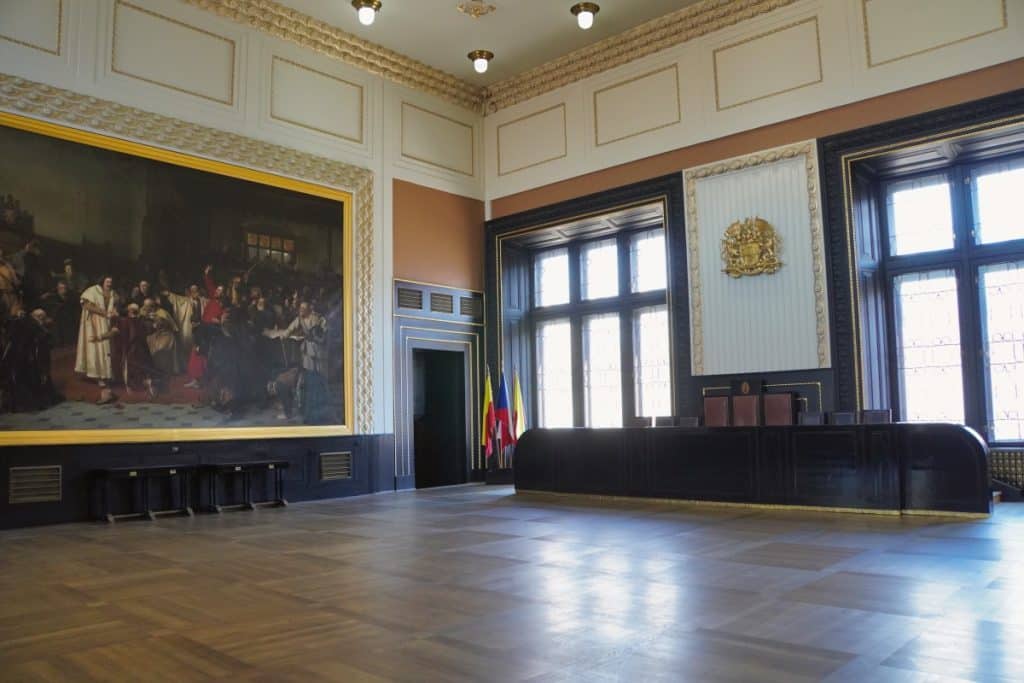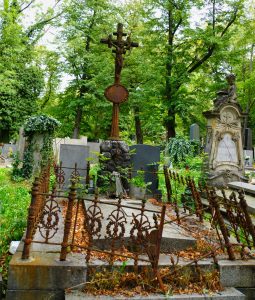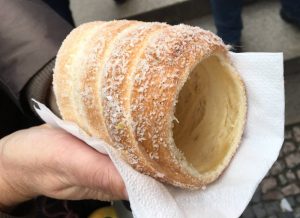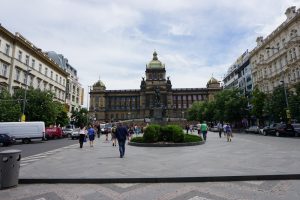Every visitor to Prague knows the Old Town Hall – but often only from the outside with a view of the impressive astronomical clock. Anyone who goes inside the town hall will be surprised at what there is to see.
The history of the Old Town Hall (Staroměstská radnice) dates back to 1338. In that year, King John of Bohemia allowed the citizens of Prague to build a town hall in the Old Town. The construction had to be financed from the wine tax.
The imposing town hall tower was completed in 1364 and has been rebuilt and renovated several times to this day. It was soon realized that the building was not big enough and so an extension was built on the west side of the building, which housed the meeting room. In 1381 the chapel in the town hall tower was completed and in 1410 the town hall clock began to tell the time for the people of Prague. From 1838, the eastern wing of the town hall was built in neo-Gothic style.


During the Prague Uprising in 1945, the building was severely damaged during the fighting on the Old Town Square. After the Second World War, the building was extensively renovated. Not all parts of the building could be preserved. Parts of the burnt-out neo-Gothic extension had to be demolished. Today there is a memorial to those who died in the uprising.
The city administration is now located in the New Town Hall. The Old Town Hall is used for events. The historic rooms can be visited.
Visit to the Old Town Hall
Visiting the historic rooms and the tower is only possible for a fee. We had bought our admission ticket in advance via Get Your Guide and were therefore able to start our visit at our chosen time slot without a long wait. In the hall, there are cash desks for priority check-in without queuing for Prague Visitor Pass holders, GetYourGuide voucher holders and people and groups with prior telephone (e-mail) reservation for a private tour.
If you want to visit the City Hall spontaneously, you can also get tickets directly on site. In this case, however, you may have to wait for a free time slot for admission.
The most important places not to be missed on your tour are the old town hall, the chapel and, of course, the tower ascent.
Entrance area
The originally unadorned entrance to the Town Hall, which retained its sparse appearance until 1902, was deemed inadequately designed by the artist Mikoláš Aleš, an outstanding Czech painter and illustrator. Aleš, who had studied at the Prague Academy of Fine Arts, was commissioned to redesign the entrance area.

The ceiling and wall paintings created by Aleš tell the story of Czech national history, starting with Princess Libuše, who prophesied the glory of Prague in her visions. St. Wenceslas, one of the country’s patron saints, and the election of George of Poděbrad as King of Bohemia, a motif that runs throughout the entire town hall, can also be found in the paintings.
A truly beautiful entrance area, which unfortunately we were unable to enter, but it is easy to see inside from the outside.
Chapel of the Old Town Hall
On the second floor of the town hall, we enter the Chapel of the Virgin Mary. A beautiful room that really impressed me.
It’s hard to believe, but there was a time when a mass was held in this sacred space before every meeting of the town council. Did the service influence voting behavior? Who knows… There were also services here for prisoners who were taken from the town hall to the scaffold and funeral ceremonies were also held there.
The chapel consists of a transept and a five-sided bay. The beautiful stained glass windows are very striking. Their color scheme dominates the room.

The centerpiece of the small chapel in Prague’s Old Town Hall is the altar, an impressive 19th-century work created by Josef Mocker, a master builder whose name is well known in Prague. Mocker was also responsible for such important buildings as the Church of St. Ludmilla in Vinohrady or the Basilica of St. Peter and Paul on Vyšehrad.
The three-winged altar immediately catches the eye with its main image: Mary holding the infant Jesus, surrounded by two figures – the patron saints Ludmilla and Wenceslas.
Next to the altar are the statues of St. Anne and St. Joseph, Mary’s parents, which were placed in the chapel in 1887.
Few people know that from the chapel of the Old Town Hall you can look inside the mechanism of the Prague Apostle Clock and see the apostles’ display.
Parish Hall
Today, the parish hall in Prague’s Old Town Hall presents itself in an astonishingly modern guise that barely gives an idea of what this room may have looked like around 1340. It was once the hub of the town hall, a place where municipal representatives made important decisions. Not only was the political course set here, but marriages were also concluded.

Unfortunately, the wall paintings that once adorned the hall fell victim to the destruction of the Second World War. Today, only the two neo-Gothic portals that survived the catastrophe bear witness to the original splendor and significance of the room. The coat of arms of the city of Prague is emblazoned on the wall. In addition, four mayors gaze down from the side walls – remnants of a tradition that once included 34 portraits of the city’s leaders. Every mayor was immortalized here in a portrait from the 17th century until around 1922.
An inconspicuous, small staircase leads visitors on past a locked door that served as the entrance to a prison in medieval times. Defendants were held here before their trial in the adjoining room.
Old Town Hall
Prague’s Old Town Hall is home to the Old Council Chamber, a striking late Gothic room known for its architectural and historical significance. I was very impressed by the design of the walls when I entered the hall.

The statues surrounding the room, including a prominent depiction of Jesus above an angel, are a reminder of the hall’s use as a courtroom in times gone by. In addition to these religious motifs, the coats of arms of the craft guilds from the 15th and 16th centuries can also be seen.
Three coats of arms represent the historical development of the city: the Gothic coat of arms of the 15th century, the Baroque coat of arms of the 17th century and the modern coat of arms, which was introduced in 1928. These coats of arms reflect the different phases in Prague’s history.

Brožík Hall
The Brožík Hall of the Old Town Hall in Prague is an impressive room that is now used for state visits and ceremonies. It is a room that extends over two floors and was built in 1879. In contrast to the historic Old Council Chamber, the Brožík Assembly Hall is characterized by its generous dimensions.
The public has always had the opportunity to attend city council meetings from a gallery, a practice that continues to this day. It is particularly noteworthy that this hall was named after Václav Brožík, a renowned Czech painter and academy professor known for his large-format paintings.

The paintings by Brožík on display in the hall are impressively large, each measuring 5 x 7.3 meters and weighing around 600 kg. One of the works depicts the life of Jan Hus, the Czech national hero, and shows the bishop pronouncing his death sentence at the Council of Constance.
The second outstanding painting depicts the election of George of Podiebrad as king, a historical scene that took place in 1458 in the east wing of the town hall, which no longer exists today.
Ascent of the tower
At the end of our tour, we went up to the tower of the Old Town Hall. When we got there, the elevator wasn’t working (but we were told this at the entrance). So we set off to climb the tower on foot.

At the time of its construction, the tower was the tallest building in Prague. There was a room under the roof for the tower guard. He had to warn the townspeople with a signal in case of danger.
Today, you can walk around the tower on a narrow viewing gallery and enjoy the wonderful view of the city. You can see directly onto the lively Old Town Square with its historic buildings and the many people who spend time there. The red roofs of the Old Town stand out and form a contrast to the green treetops and gray streets.

Prague Castle is visible in the distance, perched on a hill overlooking the city. The silhouette of St. Vitus Cathedral on the castle grounds is clearly visible. Also striking is the Vltava River, which meanders through the city and is spanned by bridges, including the famous Charles Bridge with its statues.


Opening hours:
January – March
Monday: 11-19 h
Tuesday-Sunday: 10-19 h
April – December
Monday: 11 -20 h
Tuesday – Sunday: 9-20 h
Entrance fees:
Adults: 300 Kč
Discounts are offered.
Book great tours through Prague
Good to know
The admission ticket purchased is valid for the town hall tower, the chapel, the representative halls and the Romanesque-Gothic cellar.
The main entrance is not barrier-free (2 steps). There is only one step at a side entrance, which can be overcome with a mobile wooden ramp. The Town Hall Tower is the only one of Prague’s medieval towers to be completely barrier-free – a modern glass elevator takes visitors up to the viewing gallery.
There is a barrier-free toilet on the 3rd floor, which can be opened with a Euro key.





































Leave a Reply